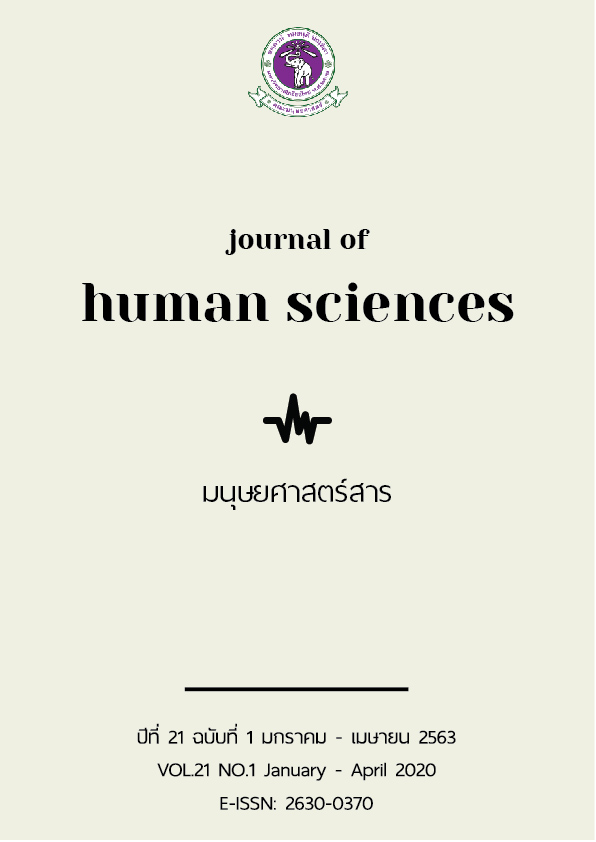พุทธสิกขากับการพัฒนาทุนมนุษย์ประเทศไทย 4.0
Main Article Content
บทคัดย่อ
ยุทธศาสตร์การพัฒนาประเทศไทย 4.0 หนึ่งในมิติการพัฒนาที่สำคัญ คือการพัฒนาศักยภาพทุนมนุษย์ให้มีความสมบูรณ์เป็นคนดีพร้อมด้วยคุณธรรมจริยธรรม มีระเบียบวินัย มีจิตสำนึกที่ดีต่อสังคม (กระทรวงอุตสาหกรรม, 2016; วรวรรณ, 2018) การพัฒนาทุนมนุษย์ของประเทศถือว่าเป็นความสำคัญที่สุดที่จะเป็นแรงผลักดันนำพาประเทศสู่ความเจริญอย่างยั่งยืนประเด็นสำคัญในการพัฒนาทุนมนุษย์คือ การศึกษาหรือในทางศาสนาพุทธเรียกว่า ‘สิกขา’ ดังนั้นคำว่าพุทธสิกขาจึงหมายความว่าการศึกษาตามวิถีพุทธศาสนา บทความวิชาการนี้ผู้เขียนมีวัตถุประสงค์เพื่อแสดงให้เห็นถึงแนวทางการพัฒนาทุนมนุษย์หรือการให้การศึกษาในเชิงพุทธศาสนา นอกจากนี้ผู้เขียนได้ศึกษาแนวคิดปรัชญาการพัฒนาทรัพยากรมนุษย์ตามแนวทางตะวันตกที่ได้รับความนิยมใช้ในองค์กรต่างๆ อย่างแพร่หลายให้เป็นองค์กรแห่งการเรียนรู้นั่นก็คือ แนวคิดวินัย 5 ประการของ ปีเตอร์ เซ็นต์เจ้ (Peter Senge) และแนวคิดการพัฒนาสมรรถนะสำหรับศตวรรษที่ 21 จากนักวิชาการชาวต่างประเทศ พร้อมกับงานวิจัยของนักวิชาการไทยเกี่ยวกับการศึกษาแนวพุทธ พบว่ามีทั้งความใกล้เคียงกันกับแนวทางพัฒนาทุนมนุษย์ตามแนวคิดตะวันตกและความแตกต่างกันในบางประเด็น เช่น การมองภาพรวมอย่างเป็นระบบของธรรมชาติมีความเกี่ยวข้องกัน ความเป็นนายตัวเองในการมีระเบียบวินัย การมองตนเองในความเชื่อฝังใจและความสัมพันธ์กับผู้อื่น อย่างไรก็ตามด้านที่แตกต่างกันคือ การพัฒนาทุนมนุษย์ทางตะวันตกเน้นการพัฒนาด้านความประพฤติของคนซึ่งเป็นคุณลักษณะภายนอก ส่วนการพัฒนามนุษย์ด้านพุทธศาสนาเน้นการพัฒนาภายในจิตใจของคนเพื่อเปลี่ยนพฤติกรรม นอกจากนี้ผู้เขียนเห็นว่าสังคมไทยปัจจุบันมีความอ่อนแอมากและเห็นว่าสมควรนำหลักคำสอนทางศาสนามาบูรณาการในการพัฒนาทุนมนุษย์รุ่นใหม่อย่างเร่งด่วน อีกประเด็นหนึ่งที่อยากแสดงให้เห็นว่าความเชื่อของชาวพุทธต่อคำพังเพยที่กล่าวว่า “แข่งเรือแข่งพายแข่งได้ แข่งบุญแข่งวาสนาแข่งไม่ได้” จากการศึกษาพบว่าไม่เป็นความจริงเพราะบุญมาจากกรรม หรือการกระทำ ส่วนวาสนา คือพฤติกรรมที่ได้ผ่านการอบรมสั่งสมมาจนกลายเป็นลักษณะประจำตัว เช่น การพูด การเดิน แสดงให้เห็นว่ามนุษย์สามารถสร้างบุญและสร้างวาสนาได้ด้วยการศึกษา ฝึกฝน และอบรมด้วยองค์ประกอบหลักสามประการ คือ ศีล สมาธิและปัญญา
Article Details
เอกสารอ้างอิง
Becker, S. G. (1993). Human capital (3rd ed). London: University of Chicago Press.
Changkhwanyuen, P. (2017). Preecha thatsana manut sangkhom læ kansưksa [Preecha’s Perspective on Humanity, Social and Education]. Bangkok: Sodsrisaditwong Foundation.
Dockthaisong B. (2008). Kanchatkan thun manut [Human Capital Management]. Bangkok: Pimtawan
Fukuyama, F. (2013). What is governance? governance. An International Journal of Policy Administration and Institutions, 26(3). 347-368.
Hoy, K. W., & Miskel, G. C. (2005). Educational administration: theory, research, and practice. Singapore: McGrawhill.
Hunchangsith, B. (2006). Setthasat sapphayakon manut (Phim khrang thi 3) [Economics of Human Resources (3rd ed)]. Bangkok: O.S. Printing House.
Khamkhiew, W. (2010). Kan wikhro ʻongkhwamru dan kanphatthana manut chak ʻongkhwamru thang phra phut satsana [The Analysis Conceptual of Human Resource Development from the Buddhism Knowledge Concept]. Bangkok.: n.p.
Marquardt, J. M. (2002). Building the learning organization (2nd ed). CA: Davies-Black.
Ministry of Industry. (2016). Yutthasat kanphatthana ʻutsahakam Thai 4.0 [The Industrial Development Strategy of Thailand 4.0]. Retrieved from https://www.oie.go.th.
Nogmerod, S. (2015). Karabun na kanka raphat nat rap yok rom nut tam thritsadi tawantok kap lakkan thang phut satsana [The Integration of Human Resource Development According to Western Theory and Buddhism Concept]. Journal of Humanities and Social Sciences, 23(41).
Phlikhamin Worawan, P. (2018). Næothang kanphatthana kamlang khon hai sotkhlo̜ng kap yutthasat kho̜ng prathet [The Integration of Human development aligning to the Country’s Policy]. Bangkok: n.p.
Prapromkunaporn. (2004). Ratthasat phưa chat kap ratthasat phưa lok [Political Science for Nation versus Political Science for the World]. Bangkok: Pimsauy.
Prathampithok. (1993). Cha phatthana khon dai ya rai: phut satsana kap kanphatthanamanut [How to Develop Human: Buddhism and Human Resource Development]. Bangkok: Sahathammamik.
Prathampithok. (1999). Kansưksa kap kanphatthana sapphayako̜n manut [Education and Human Resource Development]. Bangkok: Sahathammamik.
Senge, P. (2006). The fifth discipline. Sydney: Currency Doubleday.
Sinlarat, P. (2017). Kansưksa 4.0 pen ying kwa kansưksa (Phim khrang thi 4) [4.0 Education is more than Education (4th ed)]. Bangkok: Chulalongkorn University.
Soland, J., Hamilton, S. L., Stecher, M. B. (2013). Measuring 21st competencies: guidance for educators. Asia Society Global Cities Education Network: RAND Corporation.
Suebvises, P. (2018). Kanphatthana sapphayako̜n manut: botrian bæp ʻong ruam læ kanprayukchai kap næokhit thi laklai [Human Resource Development: the Integrated Learning and Practice with Multi-concept]. Bangkok: Rattanatrai.
Techsauce. (2018). Nai singkhapo chi krabuankan khit chœng ʻo̜k bæp champen to̜ kan plianplæng kho̜ng prathet [Singapore’s Prime Minister said the Design Thinking Process changed the country to first world]. Retrieved from https://techsauce.co
Wasi, W. (2002). Withi manut nai satawat thi yisipʻet: su phop phum mai hæng kanphatthana [The Human Way of Life in 21st Century: the Drive to New Development]. Bangkok: Sodsrisaditwong Foundation.
Watthanabut, B. (2015). Phut withi kanphatthana sapphayako̜n manut pha tai prachakhom ʻAsian: Phraphotthasatsana kap withi lok [The Development of Human Resources by Buddism Concept for ASEAN: Buddhism and the World Crisis]. Journal of Mahachula Academic, 2.


